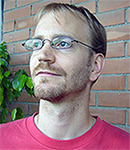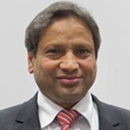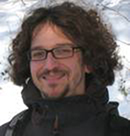Lectures (confirmed)
Matthias Auf der Maur - University of Rome Tor Vergata - Italy

from October 2004 to March 2008 he did a PhD at the OLAB, University of Rome "Tor Vergata", working on the development of a new multiscale simulator for electronic and optoelectronic devices .Since 2008 he is researcher with the Dept. of Electronics engineering of University of Rome "Tor Vergata".
http://www.optolab.uniroma2.it/team/staff/67-matthias-auf-der-maur.html
Multiscale simulation approaches combining models on different scales from the atomistic to the continuous are gaining increasing importance for the simulation of electronic devices. In this lecture approaches for such coupled simulations are presented, which are suitable for electronic transport and optical properties in inorganic and organic semiconductor devices. The necessity for multiscale simulations will be discussed, and different coupling schemes like the bridge and overlap methods are introduced. The particular interest in multiscale approaches for modeling of solar cells will be addressed. Since in most cases device simulations are multiphysics problems, we illustrate how the relevant models describing strain (linear elasticity, valence force fields), electronic states (k-dot-p, tight-binding), electronic transport (drift-diffusion, Monte-Carlo, non-equilibrium Green’s functions) and optical properties (Lambert-Beer, Maxwell solution-based) can be integrated in a multiscale/multiphysics simulation environment. The interaction between atomic and continuous media models is described, focusing on a top-down approach where the generation of the atomic structure is based on the macroscopic device description, including the association between atomic structure and finite element mesh and interpolation of physcial quantities. Examples of coupled simulations of III-nitride based quantum well and quantum dot structures, nanocolumns and transistors will demonstrate the main features and critical points of multiscale device simulations.
Fernando Araujo de Castro National - Physical Laboratory - UK

leads research on solar photovoltaics and organic electronics at the National Physical Laboratory (UK). Current work focuses on innovative metrology to support materials and product development in three broad areas: performance (from nano- to macroscale), durability and large-area characterisation.
http://www.researchgate.net/profile/Fernando_Araujo_de_Castro
Starting from a brief overview of the current photovoltaics market and requirements for upcoming solar cell technologies, the lecture will focus on why reliable measure
Anna Battaglia - 3SUN - Italy

Anna Battaglia from 3Sun srl. Over 15 years of successful experience in the semiconductor industry. Results oriented with strong interpersonal and organizational skills. Working knowledge of analytical tools (SIMS, RBS, Auger, Raman, TEM)
https://www.linkedin.com/pub/anna-battaglia/2/388/a53
Aldo Di Carlo - University of Rome Tor Vergata - Italy

In the last years his research activities focussed on the charge trasport in nanostructured devices, HEMT, organic TFT, molecular devices and CNT-FET. Recently, was involved in the realization of the "Polo Solare Organico della Regione Lazio" (Center for Hybrid and Organic Solar Energy) CHOSE and he is actually codirector of the center. Aldo Di Carlo is local principal investigator of one H2020 project and 4 FP7 project. He is node coordinator for the EU FP7 Project SMASH devoted to Nanowire LEDs with Osram as European Coordinator.
http://www.optolab.uniroma2.it/team/staff/63-aldo-di-carlo.html
Suren Gevorgyan - DTU - Denmark

has been specializing in characterization and optimization of organic photovoltaic technologies for several years. Suren has graduated from Yerevan State University and Ben-Gurion University specializing in physics and received his PhD at the Technical University of Denmark specializing in organic photovoltaics. His current research interests are focusing on characterization and stability testing, round robin studies, qualification tests, electro-optical analyses and device encapsulation for organic photovoltaics
http://www.cheetah-exchange.eu/expertise.asp?i=3
Organic photovoltaic (OPV) technologies continue receiving skeptical approach from the industry and decision makers, despite the rapid progress in the device efficiency demonstrated in recent years. One of the primary reasons is the concern over the lifetime and the upscaling of the OPV products. Despite the promising literature reports it remains unclear what is the lifetime of the OPVs today, if the OPVs can become a reliable technology and if they can be manufactured in mass production. The talk will give a general overview of what is the status of the OPV stability today and what is expected in the near future. A list of failure mechanisms will be discussed, as well as various methods will be addressed that help improving the stability of the OPV technologies. This will follow with the discussion of the challenges related to upscaling of OPVs and what has been accomplished so far.
Emmanuel Kymakis - TEI of Crete, School of Engineering - Grece

is an Associate Professor at the Electrical Engineering Department of TEI of Crete, where he heads the Nanomaterials & Organic Electronics group of the Center of Advanced Materials & Photonics. He received the B.Eng. (First Class) degree in Electrical Engineering & Electronics from Liverpool University 1999 and the Ph.D. degree in Electrical Engineering from Cambridge University in 2003. He and Prof. Gehan Amaratunga are the inventors of the polymer-nanotube solar cell.
Organic photovoltaics (OPVs) are among the most promising photovoltaic technologies for long term sustainable energy production. Incorporation of plasmonic nanoparticles for absorption enhancement offers an attractive way to realized OPVs with efficiencies higher than 10%. On the other hand, the utilization of solution processable graphene in OPVs can offer many advantages such as the possibility of producing and processing them in large quantities, in a cost effective manner. Furthermore, graphene and graphene-like 2d materials can replace traditional electrodes, or buffer layers, but more importantly enable whole new device concepts, at longer term. In this lecture, I will report the current status on solution processable graphene (SPG) materials development and plasmonic device engineering to significantly enhance the performance and stability of OPVs. In particular, I will address recent advances in the rapidly developing field of plasmonic OPVs, in which various metal nanostructures (NPs) are introduced into the device. The effects induced by the NPs incorporation will be examined from the optical and electrical aspects. In the second part of my talk, I will give an overview of the progress of the recent research on graphene and its derivatives utilization as various components in OPVs, including transparent electrodes, buffer and active layers. Particular attention will be paid to the functionalization, doping and processing of graphene derivatives targeting in tunable optoelectronic properties with respect to the specific targeted application.
Md. K. Nazeeruddin - EPFL - Switzerland

is an expert in the design, synthesis and characterization of platinum group metal complexes associated with Dye-sensitized Solar Cells and Organic Light Emitting Diodes. He has in-depth experience with all characterization tools, necessary for coordination complexes.
Vittorio Pellegrini - Italian Institut of Technology - Italy

is senior researcher at the Italian Institute of Technology (IIT) in Genova and director of the IIT center of two-dimensional materials and graphene. He is the Italian representative of the European flagship project on graphene and deputy coordinator of the work-package ENERGY. Pellegrini's research interests focus on the physics and application of low-dimensional semiconductor systems and graphene.
http://graphene.iit.it/people/principal-investigators/item/vittorio-pellegrini.html
Alison Walker - Bath University - UK

attended the University of Oxford and obtained an MA and then a DPhil. Alison became a Research Associate at Michigan State University in the USA. She then moved back to the UK and worked as Senior Research Associate at a scientific research laboratory. Alison was given a lectureship, working initially at the University of East Anglia before moving to the University of Bath. She was appointed Professor of Physics in 2008. Alison’s field of research is computational condensed matter physics, and her current research areas are modelling plastic electronic devices and novel solar cells.
http://staff.bath.ac.uk/pysabw/
The lecture will describe the Kinetic Monte Carlo approach for calculating solar cell characteristics and show how it is linked to molecular dynamics studies that in turn are related to electronic structure calculations.
Birger Zimmermann - Fraunhofer ISE - Germany

works on organic PV at Fraunhofer ISE since 2003 and is currently head of the team “Production Technology for Organic Solar Cells” developing novel cell-stacks and module concepts for very low cost roll-to-roll production of organic solar cells. He is author and co-author of numerous publications and coordinated the Fraunhofer ISE contributions of the FP7 projects “HiFlex” and “FabriGen” as well as several national R&D projects.
http://www.cheetah-project.eu/consortium/fraunhofer.html
The lecture will give an overview of the construction principles of photovoltaic devices with special focus on organic solar cells. Coming from a functionality perspective (charge carrier separation, recombination, light incoupling, current collection), concrete materials and device stacks of state of the art organic solar cells as well as different module architectures will be presented, showing their possible advantages and remaining challenges. The interrelation between the final module architecture and device stack will be discussed as well.
Lucio Cina' - Center of Hybrid and Organic Solar Energy - Italy

is specialized in temporal transient characterization techniques for hybrid solar cells. He is developing an all-in-one measurement system for a complete electro-optical analysis of photovoltaic devices. Lucio received his PhD in Electronic Engineering at University of Rome "Tor Vergata" specializing in hybrid photovoltaics. From 2013 he is post-doc researcher at the Center for Hybrid and Organic Solar Energy (CHOSE) of the same university.
http://www.chose.uniroma2.it/postdoc/139-lucio-cina.html
Urša Opara Krašovec - University of Ljubljana - Slovenia

is a chemist working on the field of material science – developing different kinds of materials/layers/components for devices that are connected to Solar Energy (solar cells, smart windows, solar collectors …). Presently, she is a senior researcher at the University of Ljubljana, Faculty of Electrical engineering leading the recently established group devoted to the development of materials.
www.scopus.com/authid/detail.url?authorId=15723558100
Building Integrated PV systems (BIPV) in modern buildings with a large glazing area is a topic generating much interest; since they can significantly contribute to the amount of electrical energy produced from renewable resources taking into account also the building aesthetics and providing additional functions to the building envelope. However, at the same time it is necessary to overcome indoor overheating and glare issues in such a building. Switchable windows provide a solution to this problem as they can be switched between the dark to the bleached state without disturbing the visual contact with outdoor surrounding. A smart solution offers a product combining photovoltaic (e.g. DSSC components) and electrochromic (EC) device which could improve the power balance of buildings beyond the extent of using PV or EC device alone. The state of the art and the current progress of the combined PV-EC components/materials integrated in a single device will be presented taking into account also the recent developments within the ongoing WINSMART (FP 7 project).The combined PV-EC devices will be discussed also within the context of the MultiscaleSolar COST Action. These devices are a suitable topic for the multiscale research developed by this collaborative network which studies these issues from the atomistic to device scales in order to further evaluate their industrial perspective.




